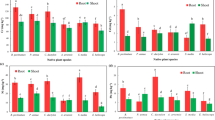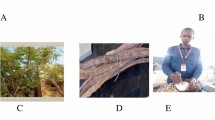Abstract
Eight halophytic plant species, Avicennia marina, Avicennia alba, Bruguiera gymnorrhiza, Lumnitzera racemosa, Rhizophora mucronata, Rhizophora apiculata, Suaeda maritima, and Xylocarpus moluccensis were evaluated for the removal ability of total dissolved solids (TDS) from plastic industrial effluent. All halophytic plants could tolerate and survive when grown in wastewater with high TDS. Among the test plants, S. maritima showed the highest TDS removal capability and was selected for further study. S. maritima had ability not only for TDS removal, but also for reduction of pH, electrical conductivity, and salinity from wastewater effluent under soil conditions. S. maritima did not exhibit symptoms such as necrosis and leaf tip burn during the experimental period. These results indicated that S. maritima has tolerance to high TDS and salinity. However, S. maritima responded to high TDS stress by producing proline and total sugar in the roots, stems, and leaves which indicated that this plant can adapt to wastewater with high TDS. In addition, silicon (Si) and calcium (Ca) were increased in the leaves due to plant stress from TDS. Therefore, S. maritima is suitable halophytic plants for treatment of TDS contaminated wastewater.


Similar content being viewed by others
References
Amini, F., & Ehsanpour, A. A. (2005). Soluble proteins, proline, carbohydrates and Na+/K+ changes in two tomato (Lycoersicon esculentum Mill.) cultivars under in vitro salt stress. American Journal of Biochemistry and Biotechnology, 1, 204–208.
APHA. (1998). Standard methods for the examination of water and wastewater (20th ed.). Washington DC, USA: American Public Health Association.
Ashraf, M., & Harris, P. J. C. (2004). Potential biochemical indicators of salinity tolerance in plants. Plant Science, 166, 3–16.
Basha, C. A., Ghosh, P. K., & Gajalakshmi, G. (2008). Total dissolved solids removal by electrochemical ion exchange (EIX) process. Electrochimical Acta, 54, 474–483.
Bates, L. S., Waldren, R. P., & Teare, I. D. (1973). Rapid dertermination of free proline for water-stress studies. Plant and Soil, 39, 205–207.
Dipu, S., Anju, A., Kumar, V., & Thanga, S. G. (2010). Phytoremediation of dairy effluent by constructed wetland technology using wetland macrophytes. Global Journal of Environmental Research, 4, 90–100.
Dubois, M., Gilles, K. A., Hamilton, J. K., Rebers, P. A., & Smith, F. (1956). Colorimetric method for determination of sugars and related substances. Analytical Chemistry, 28, 350–356.
Epstein, E. (1999). Silicon. Annual Review of Plant Physiology and Plant Molecular Biology, 50, 641–644.
Epstein, E. (2001). Chapter 1 silicon in plant: facts vs. concepts. Studies in Plant Science, 8, 1–15.
Ezawa, S., & Tada, Y. (2009). Identification of salt tolerance genes from the mangrove plant Bruguiera gymnorhiza using Agrobacterium fuctional screening. Plant Science, 176, 272–278.
Flowers, T. J., & Hall, J. L. (1978). Salt tolerance in the halophyte, Suaeda maritima (L.) Dum.: the influence of the salinity of the culture solution on the content of various organic compounds. Annals of Botany, 42, 1057–1063.
Khosravi, M., Taghi Ganji, M., & Rakhshaee, R. (2005). Toxic effect of Pb, Cd, Ni and Zn on Azolla filiculoides in the International Anzali Wetland. International journal of Environmental Science and Technology, 2, 35–40.
Khosravinejad, F., Heydari, R., & Farboodnia, T. (2009). Effect of salinity on organic solutes contents in barley. Pakistan Journal of Biological Sciences, 12, 158–162.
Mahajan, S., & Tuteja, N. (2005). Cold, salinity and drought stresses: an overview. Archives of Biochemistry and Biophysics, 444, 139–158.
Ministry of Industry in Industrial Effluent Standard. (1996). Ministry of Industry, Bangkok, Thailand.
Misha, A., Yadav, A., Agaiwal, M., & Bajipai, M. (2004). Fenugreek mucilage for solid removal from tannery effluent. Reactive and Functional Polymers, 59, 99–104.
Park, J., Okita, T. W., & Edwards, G. E. (2009). Salt tolerant mechanisms in single-cell C4 species Bienertia sinuspersici and Suaeda aralocaspica (Chenopodiaceae). Plant Science, 176, 616–626.
Prokop'ev, E. P. (2001). Ecology of plants (p. 370). Tomsk: Tomskij gosudarstvennyj universitet.
Ridge, I. (2002). Plants (1st ed.). New York: Oxford.
Romero-Aranda, R., Soria, T., & Cuartero, J. (2001). Tomato plant-water uptake and plant-water relationships under saline growth conditions. Plant Science, 160, 265–272.
Shu, L. Z., & Liu, Y. H. (2001). Effect of silicon on growth of maize seedling under salt stress. Agro-environmental Protection, 20, 38–40.
Thiery, L., Leprince, A., Lefebvre, D., Ghars, M. A., Debarbieux, E., & Savoure, A. (2004). Phospholipase D is a negative regulator of proline biosynthesis in Arabidopsis thaliana. Journal of Biological Chemistry, 279, 14812–14818.
Troke, P. F., & Yeo, A. R. (1977). The mechanism of salt tolerance in halophytes. Annual Review of Plant Physiology, 28, 89–121.
Tuteja, N. (2009). Integrated calcium signaling in plants. In F. Baluska & S. Mancuso (Eds.), Signaling in plant (Springer, pp. 29–49). Germany: Berlin Heidelberg.
Wahome, P. K., Jesch, H. H., & Grittner, I. (2001). Mechanisms of salt stress tolerance in two rose rootstocks: Rosa chinensis ‘Major’ and R. rubiginosa. Scientia Horticulturae, 87, 207–216.
Weber-Scannell, P. K., & Duffy, L. K. (2007). Effects of total dissolved solids on aquatic organism: a review of literature and recommendation for salmonid species. American Journal of Environmental Sciences, 3, 1–6.
Yang, Y., Wei, X., Shi, R., Fan, Q., & An, L. (2010). Salinity-induced physiological modification in the callus from halophyte Nitraria tangutorum Bobr. Journal of Plant Growth Regulation, 29, 465–476.
Zhu, Z., Wei, G., Li, J., Quan, Q., & Yu, J. (2004). Silicon alleviates salt stress and increase antioxidant enzymes activity in leaves of salt-stressed cucumber (Cucumis sativus L.). Plant Science, 167, 527–533.
Acknowledgments
This research is supported by the Thailand Research Fund through the Royal Golden Jubilee Ph.D. Program and King Mongkut’s University of Technology Thonburi (grant no. PHD/0296/2551).
Author information
Authors and Affiliations
Corresponding author
Rights and permissions
About this article
Cite this article
Saiyood, S., Vangnai, A.S., Inthorn, D. et al. Treatment of Total Dissolved Solids from Plastic Industrial Effluent by Halophytic Plants. Water Air Soil Pollut 223, 4865–4873 (2012). https://doi.org/10.1007/s11270-012-1242-1
Received:
Accepted:
Published:
Issue Date:
DOI: https://doi.org/10.1007/s11270-012-1242-1




